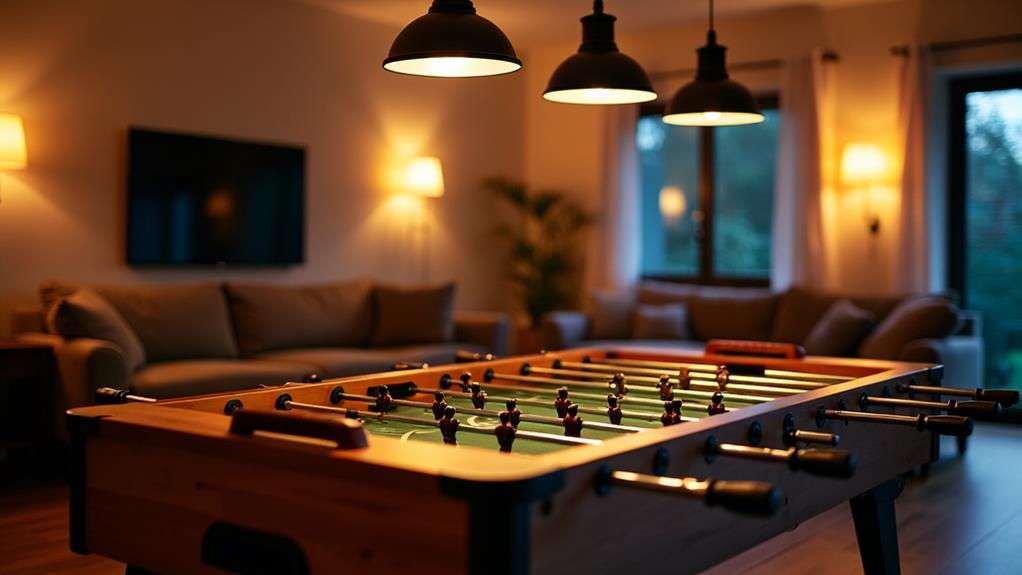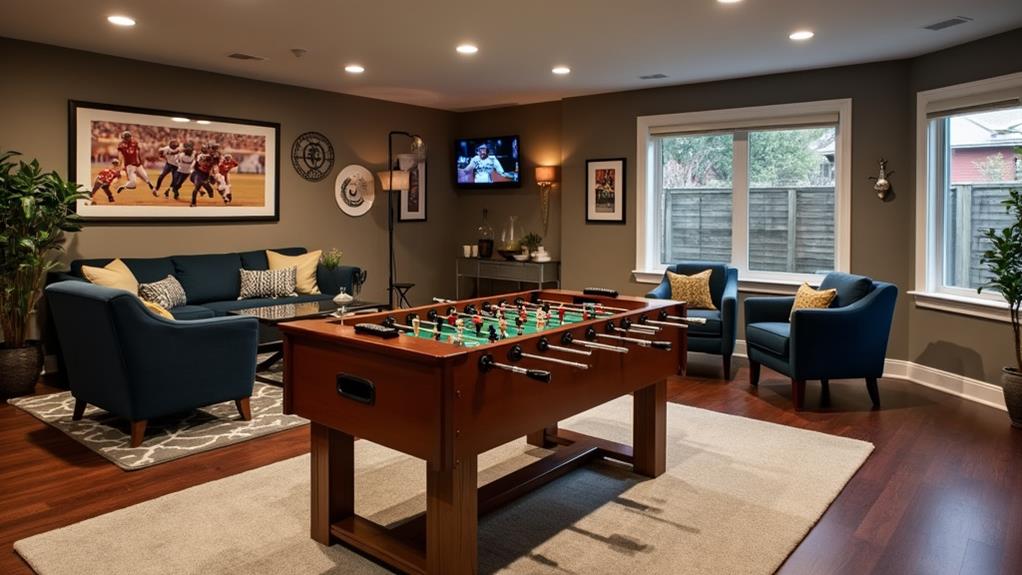What Are the 5 Bar Rules in Foosball?

Mastering foosball means understanding and sticking to five critical bar rules. Initially, no spinning the rods 360 degrees without ball contact—you'll lose possession if you do. Second, avoid jarring the table to keep things smooth and fair. Third, use proper passing techniques by ensuring the ball touches at least two figures. Fourth, manage your time on the 5-bar with a strict 10-second limit for passes. Ultimately, handle dead balls by following specific restart procedures to maintain the game's flow. Stick to these rules, and you'll play like a pro in no time.
No Spinning Allowed
Adhering to the no spinning rule in foosball is crucial for fair gameplay and skillful ball control. Spinning, defined as a 360-degree rotation of the rod without making contact with the ball, is strictly prohibited. This rule guarantees that all players rely on their skills rather than luck, promoting fair play.
When you spin the rod before taking a shot, you'll lose possession of the ball to the opposing team as a penalty. This discourages players from attempting reckless moves and encourages more strategic play. You're allowed to rotate the rod up to 90 degrees for shooting, but exceeding this limit while reaching for the ball can also result in a foul.
Consistent violations of the spinning rule can lead to disqualification, especially in competitive settings. This strict enforcement underscores the significance of mastering control rather than relying on haphazard tactics. By avoiding spinning, you're contributing to a game environment that values precision and skillful maneuvers.
Avoid Jarring the Table
Slamming the rods against the table, known as jarring, is prohibited to keep the game fair and enjoyable. When you engage in jarring the table, you're not only breaking the rules, but you're also risking penalties such as losing possession of the ball or even receiving a technical foul called by the referee. This action is often seen as a distraction tactic that undermines the integrity of the game.
To avoid jarring, keep in mind that players may rotate rods up to 90 degrees for shooting, but any excessive movement that rocks or pushes the table will be considered illegal. Understanding and avoiding jarring is vital for maintaining a smooth and enjoyable game. Adhering to the rules guarantees everyone has a fair chance at victory.
Here's why avoiding jarring matters:
- Fairness: Everyone wants a level playing field.
- Integrity: Respect the game and your opponents.
- Enjoyment: A smooth game is more fun for everyone.
Proper Passing Techniques

While avoiding jarring is key to maintaining the integrity of the game, mastering proper passing techniques is just as critical for effective gameplay. According to the 5-bar passing rule, the ball must touch at least two player figures on the 5-bar before you can advance it toward your opponent's goal. This guarantees you're making strategic plays rather than random hits.
You have a maximum of 15 seconds to complete a 5-bar pass after the initial serve, so time is of the essence. During this period, the ball can't be completely stopped; it must be in motion to maintain legal play. This keeps the game dynamic and prevents stalling.
The sidewalls of the table can be your allies. The ball may touch the sidewalls a maximum of two times during your passing attempt. Use this to your advantage for strategic wall plays. However, if you don't follow these guidelines—like making the required touches—you risk losing possession of the ball to your opponent.
Time Management on the 5-Bar
Managing your time on the 5-bar is crucial for maintaining control and dictating the pace of the game. You have a strict 10-second time limit to make a pass from the 5-bar after the ball is served. If you fail to advance the ball within this timeframe, possession is awarded to your opponent, putting you at a disadvantage. For the initial serve, you get a bit more leeway with 15 seconds to complete a 5-bar pass.
During gameplay, the ball must touch at least two player figures on the 5-bar before it can be shot or moved to another bar. This rule guarantees strategic play and prevents hasty, uncontrolled shots. Furthermore, be aware that the goalie and defense rods are considered as one bar when managing time limits, so plan your moves carefully.
To excel in time management on the 5-bar:
- Stay focused: Keep a close eye on the clock to avoid losing possession.
- Plan ahead: Think two steps ahead to guarantee smooth changes.
- Practice precision: Refine your passes to make the most of your 5-bar time.
Mastering these strategies will help you advance the ball effectively and maintain an edge in gameplay.
Handling Dead Balls

Handling dead balls in foosball is all about maintaining the flow of the game. When a dead ball occurs—meaning it's out of reach of any player figure—you've got to follow specific rules to keep things moving. If the dead ball is between opposing rods, the last scoring team gets to serve it again. This re-serve is vital for maintaining the momentum and fairness in the game.
For defensive players, if the dead ball is behind the midfield bar, it's their job to reposition it behind their defensive 2 bar. This guarantees the game doesn't stall. When the ball is dead behind the midfield, the restart happens with a kick-off by the conceding team from the nearest defender. It's important to get the ball back into play foosball-style, keeping the action continuous.



